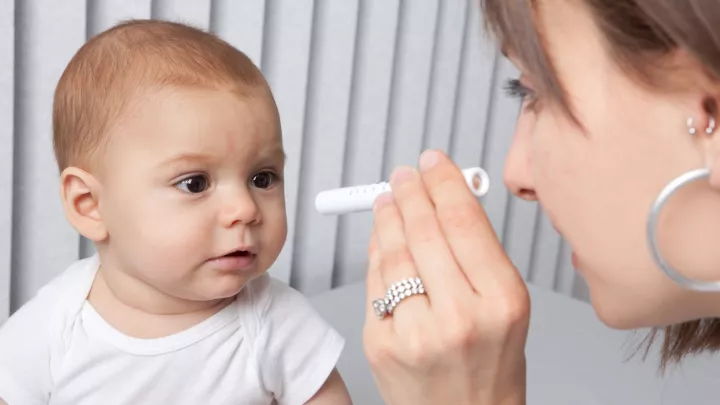Nonsurgical Eye Treatments
Many childhood eye conditions and diseases can be treated without surgery. Our ophthalmologists have expertise using nonsurgical treatments and procedures to achieve excellent outcomes. We are recognized leaders in treating retinopathy of prematurity, retinoblastoma and keratoconus with nonsurgical techniques.
Your child may receive these treatments on their own or together with eye surgery. Some nonsurgical procedures require sedation. We offer hybrid anesthesia when appropriate to limit the amount of anesthesia exposure for your child.
Nonsurgical eye treatments we offer include:
Corneal Cross Linking for Keratoconus
Keratoconus is the progressive thinning of the cornea—the clear outer layer on the front of the eye. Over time, the thinning can cause the cornea to split or become misshapen, making vision blurry and distorted. If it becomes severe, your child may need a corneal transplant.
To prevent the severe form of keratoconus, our specialists can perform a procedure called corneal cross linking to reinforce the cornea. We use ultraviolet light and eye drops to strengthen the cornea and stabilize keratoconus while your child sleeps under anesthesia.
Corrective Solutions
We use corrective eye solutions on their own and together with other treatments to help your child see better. Visual aids—such as glasses, patches and contact lenses—improve eyesight for many children living with limited vision or eye disease.
They may also be used as temporary treatment:
- Glasses may help correct eye movement disorders.
- Glasses prescribed intermittently and intentionally can help coordinate your child’s eye development with their brain development.
- Patching the eye can help to strengthen one eye’s vision when it’s weaker than the other eye.
Our pediatric optometrists have expertise and experience working with children of all ages and developmental levels. We offer specialty frames for unique face shapes and children with special needs.
Laser Treatment
Lasers are intense beams of light that can be used on eye tissue to treat certain forms of childhood blindness. Because laser treatments focus on a specific area, they can minimize damage to surrounding tissue.
Our eye specialists use laser treatment in several ways, including:
Treating retinopathy of prematurity (ROP)
Retinopathy of prematurity (ROP) is a disease that affects premature babies. It causes abnormal growth of blood vessels in the retina—the tissue at the back of the eye. Without timely and precise treatment, the abnormal growth can lead to retinal scarring and ultimately, blindness. Our specialists focus laser treatment on the retina for three reasons:
- Stop the abnormal growth
- Preserve the central retina
- Decrease the risk of the retina detaching
Treating glaucoma
Glaucoma is a condition in which poor eye drainage leads to unhealthy eye pressure. MicroPulse laser treatment helps decrease eye pressure. It can be used in children with glaucoma who cannot have surgery or who want to avoid using drainage implants.
Our ophthalmologists deliver pulsing laser energy to the surface of your child’s eye. The laser energy reduces the amount of fluid produced and increases drainage. As a result, your child’s eye pressure decreases.
Treating retinoblastoma (eye cancer)
The heat of laser treatment can destroy the tissues it touches, including retinoblastoma tumors. The types of laser therapy we use to treat retinoblastoma include:
- Photocoagulation, to destroy the blood vessels that supply the tumor
- Thermotherapy, applied directly to the tumor to kill it
Medications
Our ophthalmologists prescribe medication for several eye diseases, including:
Chemotherapy for retinoblastoma
We administer chemotherapy for eye cancer in several ways:
- Intra-arterial: We deliver small pulses of medicine through the thigh and into the artery that leads to the affected eye.
- Intravenous (IV): Medicine infused in a vein travels throughout the body. It is especially effective if your child has cancer in both eyes.
- Intravitreal injections: We inject medication directly into the eye.
Prescription eye drops for glaucoma
Our specialists closely monitor eye pressure in children with glaucoma. When necessary, they may prescribe prescription eye drops to help with drainage and regulate eye pressure.
Radiation Therapy for Retinoblastoma
We use radiation therapy to kill cancer cells associated with retinoblastoma. Your child may receive radiation therapy in addition to chemotherapy. There are two ways to administer radiation therapy for retinoblastoma:
- External radiation: radiation beams are aimed at the tumor from outside your child’s body. We use certain types of precise external radiation—such as intensity modulated radiation therapy (IMRT)—to limit damage to normal eye tissue.
- Internal radiation: Brachytherapy (plaque radiotherapy) involves placing a small amount of radioactive material on the outside of the eyeball, near the tumor. The radiation stays in place for several days before removal. Since the radiation only travels a short distance to the tumor, it causes less damage to your child’s healthy tissue.
Expert Eye Care at Children’s Hospital Los Angeles
We tailor our services to your child’s age, condition and developmental level. Learn how we diagnose and treat vision problems.
Contact us
To schedule an appointment at the Vision Center, call 323-361-2347.


